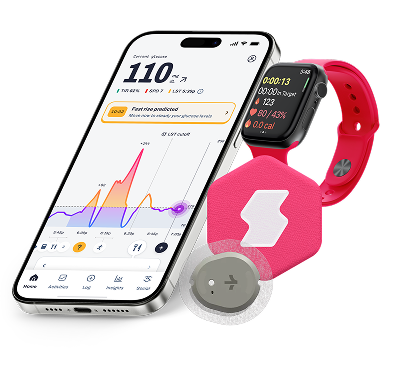Black rice, often referred to as "forbidden rice," is a nutrient-dense whole grain celebrated for its rich anthocyanin content, which contributes to its dark purple hue. With a moderate glycemic index, black rice is considered a healthier carbohydrate option, offering slower blood sugar release compared to refined grains.¹ Additionally, its high fiber and antioxidant levels may support heart health and aid in managing type 2 diabetes.²
This article will explore how black rice impacts blood sugar levels and its potential benefits in a balanced diet.
Sign up to be the first to know about special offers and exciting Signos news.
Glycemic Index Table
The Glycemic Index (GI) of black rice is typically moderate, ranging from 42 to 50 depending on its variety and cooking method.¹ Cooking can influence the GI, with longer cooking times increasing starch digestibility and slightly raising the GI.² This makes black rice a better alternative to refined grains for those looking to moderate blood sugar levels. To maximize its benefits, black rice is best consumed al dente or paired with foods that are high in fiber or protein, which help slow carbohydrate absorption.³
Using the formula GL = (GI × Carbohydrate per serving) ÷ 100 and assuming a GI of 45 (the midpoint of the range), the following calculation applies:
- Carbohydrate per serving (100g): 79.1g
- GI: 45
- GL = (45 × 79.1) ÷ 100 = 35.6
The Glycemic Load (GL) of black rice per 100g serving is approximately 35.6, indicating a moderate to high impact on blood sugar. For individuals aiming for glycemic control, it is advisable to consume smaller portions or combine black rice with low-GI foods like leafy greens or legumes to mitigate its effects.² This combination can also enhance the nutrient profile of meals by providing additional vitamins, minerals, and fiber.³

Nutritional Facts
Black rice is a nutrient-dense grain providing approximately 372 kcal per 100g serving, making it an energy-rich food option. It is high in carbohydrates (79.1 g), which serves as a primary energy source, and also contains a notable amount of protein (11.6 g), supporting muscle repair and growth.¹ Its fiber content (4.7 g) promotes digestive health, while low levels of fat (3.49 g) and sodium (0 mg) make it a heart-healthy choice.¹ Additionally, black rice is a source of iron (1.67 mg), which is crucial for oxygen transport in the blood, and it provides phosphorus, essential for bone health.¹ Unlike refined grains, black rice retains its outer bran layer, contributing to its higher nutrient content and antioxidant properties, which may benefit overall health.²
The nutritional information below is for 100g of black rice.
Nutritional Facts

Is Black Rice Good for Weight Loss?
Black rice can be a beneficial addition to a weight-loss diet due to its nutrient density and fiber content. It is naturally low in fat, cholesterol-free, and contains no sodium, making it a heart-healthy choice¹. Black rice is high in fiber, which promotes satiety and reduces hunger, potentially supporting calorie control.² Additionally, its moderate glycemic index helps to maintain steady blood sugar levels, which can be beneficial in managing cravings and energy dips throughout the day.³
Some ways to enjoy black rice include:
- Using it as a base for grain bowls
- Adding it to stir-fries or vegetable medleys
- Incorporating it into salads for added texture and color
- Pairing it with protein-rich foods like chicken or tofu for a balanced meal
- Using it as an alternative to white rice in sushi or side dishes
Is Black Rice Good for People Living with Diabetes?
Black rice is a diabetes-friendly grain when consumed in moderation, thanks to its moderate glycemic index and high fiber content. These attributes help slow the absorption of carbohydrates, minimizing sharp blood sugar spikes.¹ Its anthocyanin content has been shown to provide additional health benefits, including reducing inflammation and improving insulin sensitivity.² Moreover, black rice contains resistant starch, which may further support better blood sugar management by acting as a prebiotic to promote gut health.³
Animal studies suggest that anthocyanin-rich foods like black rice can help reduce markers of insulin resistance and inflammation, key factors associated with diabetes management.⁴ For individuals living with diabetes, pairing black rice with low-GI foods such as vegetables or lean proteins can help optimize glycemic control and ensure a balanced meal plan.
Better health starts here.
Sign up for tips and insights that work for you!
Allergies
Black rice allergies are uncommon but can still occur in sensitive individuals, causing mild to severe allergic reactions. Allergies to black rice may manifest as food protein-induced enterocolitis syndrome (FPIES) or other immune-mediated responses, particularly in those with sensitivities to rice proteins. Symptoms of black rice allergies can include gastrointestinal distress, such as nausea, vomiting, or diarrhea, as well as skin reactions like itching, hives, or redness. In severe cases, allergic reactions may lead to difficulty breathing, swelling, or even anaphylaxis.¹ The proteins responsible for allergic reactions are typically found within the rice grain and can be present in both raw and cooked forms. If you suspect an allergy, sensitivity, or intolerance to black rice, it is important to consult a healthcare professional.²

References
References
- FoodData Central, USDA. (2024). https://fdc.nal.usda.gov
- Harvard T.H. Chan School of Public Health. (2024). https://www.hsph.harvard.edu
- Glycemic Index. (2024). https://glycemicindex.com
- National Institutes of Health. (2024). https://www.ncbi.nlm.nih.gov




.svg)
.svg)
.svg)
.svg)
.svg)
.svg)
.svg)
.svg)
